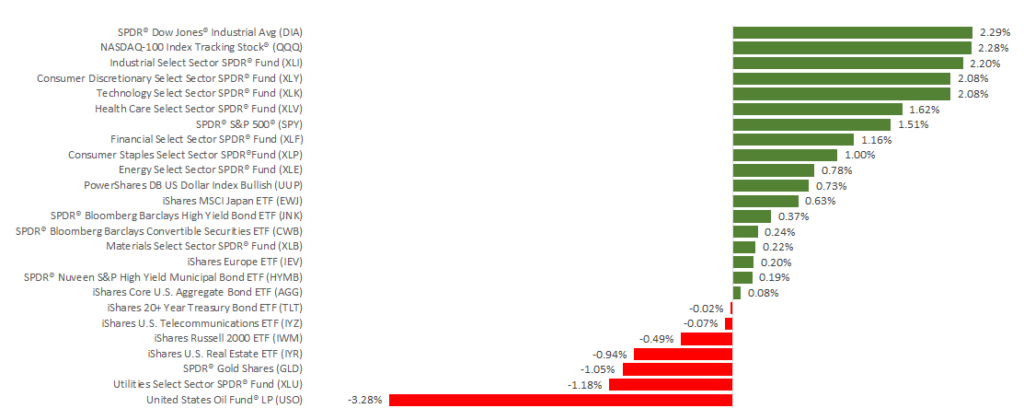
The Weekly Update
Week of July 16, 2018
By Christopher T. Much, CFP®, AIF®

Last week, trade tensions with China lessened somewhat, while the 2nd quarter corporate earnings season started with mixed results. Against this backdrop, domestic stocks experienced sizable growth. By market’s close on Friday, July 13, the S&P 500 was above 2,800 for the first time since February 1. Meanwhile, the Dow was above 25,000, and the NASDAQ had hit a new record. For the week, the S&P 500 gained 1.50%, the Dow added 2.30%, and the NASDAQ was up 1.79%. International stocks in the MSCI EAFE increased as well by 0.16%.
We are now two weeks into July, which means the 1st half of 2018 is behind us. As we analyze what may be ahead in the markets, we’ll also strive to understand what has happened so far this year.
2nd Quarter Update: Key Details to Know
- Domestic indexes had mixed results.
At the end of the 1st quarter, the NASDAQ was up by 2.3%, while both the S&P 500 and Dow were in negative territory for the year. Fast-forward to the 2nd quarter’s end, and the Dow was still down with a 1.8% loss between January and June. During the same time, the S&P 500 gained 1.7% and the NASDAQ added 8.8%. - Trade tension persisted.
Global trade was a major topic throughout the 2nd quarter. In April, the U.S. proposed $50 billion of tariffs on Chinese products—and China announced its own tariffs in response. The trade tension also extended to Canada, the EU, and Mexico as the U.S. added tariffs to steel and aluminum imports from these countries. While this situation attracted significant news coverage, investors were able to put much of their focus on economic details—such as corporate earnings—instead. - Interest rates rose.
In June, the Federal Reserve increased interest rates by 0.25%, which marks the 2nd rate hike so far this year. The Fed gave an optimistic view of the economy and said that two more increases could be ahead in 2018. - The labor market stayed strong.
In May, unemployment hit its lowest level since 2000. June’s labor report showed unemployment increasing to 4% but for a positive reason: more people reentering the job market. The latest report also showed better-than-expected job growth. Wage increases missed expectations and still have room to expand more quickly. At the same time, their steady pace should help keep inflation in check and interest rate increases continue gradually.
Looking Ahead
More 2nd-quarter data is still to come. Gross Domestic Product may have increased by as much as 5% annually between April and June. That growth rate would be over twice what we experienced in the 1st quarter. We are also at the very beginning of 2nd-quarter corporate earnings season, and analysts predict earnings growth of 20%.
Moving into the 3rd quarter, trade will likely continue to be a hot topic, but it’s far from being the only detail worth following. As we gain more information about what happened in the 2nd quarter, we will combine those perspectives with the performance we’re experiencing now. In the meantime, if you have any questions, we’re here to talk.
ECONOMIC CALENDAR:
Monday: Retail Sales
Tuesday: Industrial Production, Housing Market Index
Wednesday: Housing Starts
Thursday: Jobless Claims


